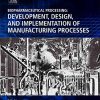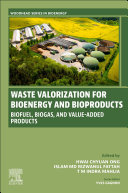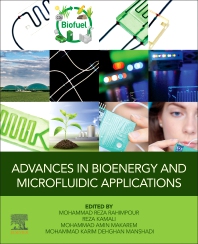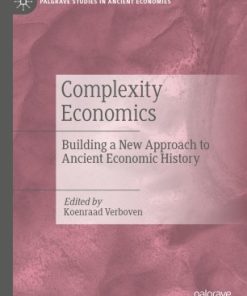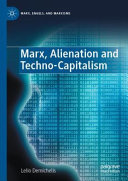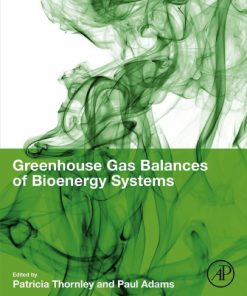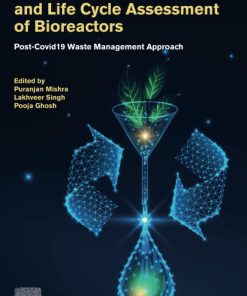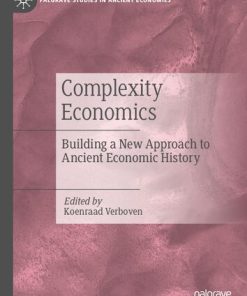Biofuels and Bioenergy A Techno Economic Approach 1st edition by Baskar Gurunathan, Renganathan Sahadevan 0323885560 9780323885560
$50.00 Original price was: $50.00.$25.00Current price is: $25.00.
Biofuels and Bioenergy: A Techno-Economic Approach 1st edition by Baskar Gurunathan, Renganathan Sahadevan – Ebook PDF Instant Download/DeliveryISBN: 0323885560, 9780323885560
Full download Biofuels and Bioenergy: A Techno-Economic Approach 1st edition after payment.
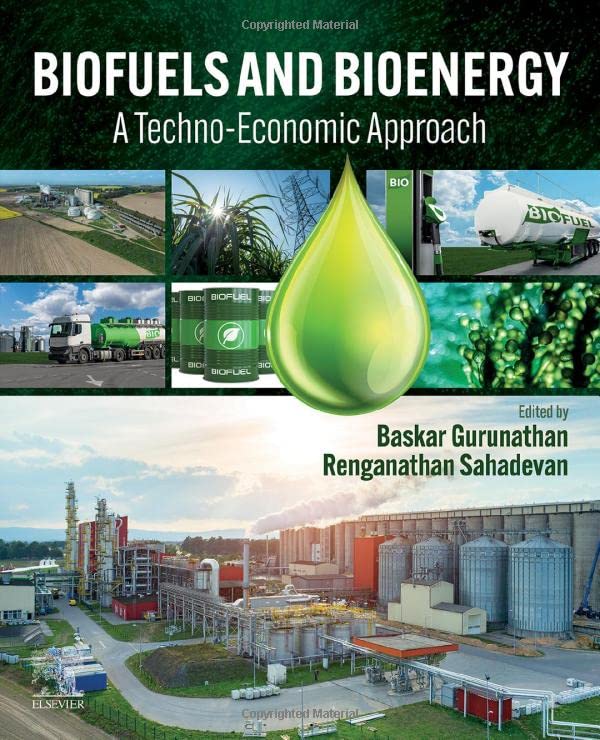
Product details:
ISBN-10 : 0323885560
ISBN-13 : 9780323885560
Author: Baskar Gurunathan, Renganathan Sahadevan
Biofuels and Bioenergy: A Techno-Economic Approach provides an in-depth analysis of the economic aspects of biofuels production from renewable feedstock. Taking a biorefinery approach, the book analyzes a wide range of feedstocks, processes and products, including common biofuels such as bioethanol, biobutanol, biooil and biodiesel, feedstocks such as lignocellulosic biomass, non-edible feedstocks like vegetable oils, algae and microbial lipids, and solid and liquid wastes, performance assessments of biodiesel in diesel engine, and the latest developments in catalytic conversion and microbial electrosynthesis technologies.
Biofuels and Bioenergy: A Techno-Economic Approach 1st Table of contents:
Section I: Biorefinery approaches in biofuels and bioenergy production
Chapter 1. Boundaries and openings of biorefineries towards sustainable biofuel production
Abstract
1.1 Introduction
1.2 Sources of biorefinery
1.3 Classification of biofuels based on biomass
1.4 Methods for biofuel production
1.5 Pretreatments
1.6 Production of different biofuels
1.7 Production of ethanol and electricity
1.8 Production of ethanol, lactic acid, and electricity
1.9 Furfural, ethanol, and electricity production
1.10 Coproduction of butanol and electricity
1.11 Production of methanol and electricity
1.12 Purification process
1.13 Biogas—biomethane production
1.14 Applications
1.15 Limitations of biorefineries
1.16 Future perspectives of biorefineries
1.17 Conclusion
References
Chapter 2. A perspective on the biorefinery approaches for bioenergy production in a circular bioeconomy process
Abstract
2.1 Introduction
2.2 Bioenergy
2.3 Bioeconomy, circular economy, and green economy
2.4 Limitations and future perspective of circular bioeconomy
2.5 Conclusion
Acknowledgment
References
Chapter 3. A comprehensive integration of biorefinery concepts for the production of biofuels from lignocellulosic biomass
Abstract
3.1 Introduction
3.2 Biomass for biorefinery
3.3 Biofuels from lignocellulosic biomass
3.4 Strategies for the treatment of lignocellulosic biomass
3.5 Metabolic engineering approaches for biofuel production
3.6 Integrated biorefinery
3.7 Constrains and challenges
3.8 Economic aspects and future of lignocellulosic biorefinery
3.9 Conclusion
Acknowledgments
References
Chapter 4. Evaluation of activated sludge derived from wastewater treatment process as a potential biorefinery platform
Abstract
4.1 Introduction
4.2 Activated sludge as a potential resource for fermentative products
4.3 Activated sludge as refinery for biogases (methane and hydrogen)
4.4 Activated sludge as a source of other organic by-products (fertilizer, refuse-derived fuel)
4.5 Conclusion
Acknowledgments
References
Chapter 5. Insights into the impact of biorefineries and sustainable green technologies on circular bioeconomy
Abstract
5.1 Introduction
5.2 Bioeconomy and circular economy collide in the circular bioeconomy
5.3 Impact of biorefinery processes on circular bioeconomy
5.4 Product usage strategies for circular bioeconomy
5.5 Reusing bio-based high-value products
5.6 Effect of biomass utilization on circular bioeconomy
5.7 Agriculture management for sustainable circular bioeconomy
5.8 Industrial and environmental policy for promoting circular bioeconomy
5.9 Conclusion
References
Section II: Biofuels and Bioenergy Production – I
Chapter 6. Fermentation technology for ethanol production: Current trends and challenges
Abstract
6.1 Introduction
6.2 Lignocellulosic biomass
6.3 The electronic structure chemistry of cellulose, hemicellulose, and lignin
6.4 Pretreatment of lignocellulosic biomass
6.5 Fermentation technology
6.6 Ethanol production using native microbes
6.7 Fermentation technology for ethanol production using recombinant engineered microbes
6.8 Trends, challenges, and future prospects in the bioethanol production
6.9 Conclusion
References
Chapter 7. Improved enzymatic hydrolysis of lignocellulosic waste biomass: most essential stage to develop cost-effective second-generation biofuel production
Abstract
7.1 Introduction
7.2 Enzymatic saccharification of lignocellulosic feedstocks
7.3 Factors influences in efficient enzymatic saccharification of lignocellulosic biomass
7.4 Reusability of cellulase enzyme to develop cost-effective enzymatic saccharification process
7.5 Economic aspects and future prospective of enzymatic saccharification-based lignocellulosic biofuel production
7.6 Conclusion
References
Chapter 8. Advances and sustainable conversion of waste lignocellulosic biomass into biofuels
Abstract
8.1 Introduction
8.2 Biofuel: A sustainable fuel for future
8.3 Lignocellulose: A potential substrate for the biofuel product
8.4 Pretreatment methods for lignocellulose biomass
8.5 Sources of lignocellulose biomass
8.6 Analysis
8.7 Potential microbial strains involved in biofuel productions
8.8 Fermentation methods for biofuel production
8.9 Reactor configuration
8.10 Future perspectives
8.11 Challenges
8.12 Conclusion
References
Chapter 9. Lignocellulosic biomass as an alternate source for next-generation biofuel
Abstract
9.1 Introduction
9.2 Raw materials
9.3 Lignocellulosic material
9.4 Process for converting the lignocellulose to biofuels
9.5 Conclusion
References
Chapter 10. Process intensification in biobutanol production
Abstract
10.1 Introduction
10.2 Biobutanol
10.3 Production of biobutanol
10.4 Process intensification
10.5 Process intensification in production of biobutanol
10.6 Conclusion
References
Chapter 11. Production of cellulosic butanol by clostridial fermentation: A superior alternative renewable liquid fuel
Abstract
11.1 Introduction
11.2 Production of butanol by Clostridium sp
11.3 Factors affecting butanol production
11.4 Enhancement of ABE fermentation
11.5 Butanol production from LCB
11.6 Technoeconomic analysis
11.7 Conclusion
References
Chapter 12. Biobutanol separation using ionic liquids as a green solvent
Abstract
12.1 Introduction
12.2 Butanol
12.3 Liquid–liquid extraction and ionic liquids
12.4 Butanol separation by ionic liquids
12.5 Toxicity and biocompatibility of ionic liquids
12.6 Recovery and reuse of ionic liquids
12.7 Future perspectives
12.8 Conclusion
References
Chapter 13. Synergistic prospects of microalgae after wastewater treatment to be used for biofuel production
Abstract
13.1 Introduction
13.2 Appropriate selection methods for effective biofuel production
13.3 Types of microalgae cultivation
13.4 Harvesting microalgal biomass
13.5 Biofuel production from wastewater using microalgae
13.6 Greenhouse gas mitigation
13.7 Future perspectives
13.8 Conclusion
References
Chapter 14. Concurrent reduction of CO2 and generation of biofuels by electrified microbial systems—concepts and perspectives
Abstract
14.1 Introduction
14.2 Bacterial electrotrophs
14.3 Mechanism of electron uptake
14.4 Carbon dioxide reduction and biofuels generation
14.5 Challenges and future prospects
14.6 Conclusion
References
Section III: Biofuels and Bioenergy Production—II
Chapter 15. Challenges and opportunities in large-scale production of biodiesel
Abstract
15.1 Introduction
15.2 Assessment from small-scale to large-scale production
15.3 Commercial-scale production of triglycerides
15.4 Large-scale production structure of biodiesel plant
15.5 Glycerol purification
15.6 Wastewater treatment
15.7 Cost analysis of wastewater treatment
15.8 Conclusion
References
Chapter 16. Lipid-derived biofuel: Production methodologies
Abstract
16.1 Introduction
16.2 Properties of biodiesel
16.3 Biodiesel production methodologies
16.4 Transesterification process
16.5 Overview of production methods
16.6 Conclusion
References
Chapter 17. Interesterification reaction of vegetable oil and alkyl acetate as an alternative route for glycerol-free biodiesel synthesis
Abstract
17.1 Introduction
17.2 Biodiesel
17.3 Interesterification reaction
17.4 Kinetic model of interesterification reaction
17.5 Case study: kinetic study on the biodiesel synthesis from Jatropha (Jatropha curcas L.) with methyl acetate in the presence of sodium methoxide catalyst
17.6 Conclusion
Acknowledgment
References
Chapter 18. Recent advances in lipase-catalyzed greener production of biodiesel in organic reaction media: Economic and sustainable viewpoint
Abstract
18.1 Introduction
18.2 Recent literature survey of lipase-catalyzed synthesis of biodiesel
18.3 Reaction parameters
18.4 Economic and sustainable viewpoint
18.5 Conclusion
References
Chapter 19. Efficient utilization of seed biomass and its by-product for biodiesel production
Abstract
19.1 Introduction
19.2 Second-generation feedstock for biodiesel production
19.3 Problems in the exploitation of nonedible oils
19.4 Deoiled seed meal after oil extraction
19.5 Seed cake as a catalyst for esterification process
19.6 Factors influencing seed cake catalyst preparation
19.7 Characterization of catalyst
19.8 Conclusion
References
Chapter 20. Catalytic pyrolysis for upgrading biooil obtained from biomass
Abstract
20.1 Introduction
20.2 Catalytic fast pyrolysis of biomass
20.3 Commercial-scale pyrolysis plant
20.4 Types of catalysts used in pyrolysis
20.5 Chemical reactions in catalytic fast pyrolysis
20.6 Reactors for catalytic pyrolysis
20.7 Process parameters
20.8 Challenges and recommendations
20.9 Future perspectives
20.10 Conclusion
Acknowledgments
References
Chapter 21. Recent trends in the pyrolysis and gasification of lignocellulosic biomass
Abstract
21.1 Introduction
21.2 Pyrolysis
21.3 Gasification
21.4 Future of pyrolysis and gasification
21.5 Conclusion
References
Chapter 22. Experimental investigation of performance of biodiesel with different blends in a diesel engine
Abstract
22.1 Introduction
22.2 Experimental section
22.3 Results and discussion
22.4 Conclusion
References
Section IV: Technoeconomic and environmental impact analysis of biofuels and bioenergy
Chapter 23. Technoeconomic evaluation of 2G ethanol production with coproducts from rice straw
Abstract
23.1 Introduction
23.2 Process description of rice straw to ethanol and coproducts
23.3 Process design
23.4 Results and discussion
23.5 Future perspective
23.6 Conclusion
References
Chapter 24. Technoeconomic analysis of biodiesel production using noncatalytic transesterification
Abstract
24.1 Introduction
24.2 Characteristics of supercritical methanol
24.3 Reaction kinetics of transesterification
24.4 Upshots of operating parameters on biodiesel using SCM
24.5 Technoeconomic analysis of SCM method
24.6 Conclusion
References
Chapter 25. Techno-economic analysis of biodiesel production from nonedible biooil using catalytic transesterification
Abstract
25.1 Introduction
25.2 Nonedible source for biodiesel production
25.3 Catalyst for biodiesel production
25.4 Techno-economic analysis
25.5 Techno-economic analysis of biodiesel production
25.6 Conclusion
Reference
Chapter 26. Technoeconomic analysis of biofuel production from marine algae
Abstract
26.1 Introduction
26.2 Macroalgae production
26.3 Extraction of oil from macroalgae for biodiesel production
26.4 Production of biodiesel
26.5 Production of biogas from macroalgae
26.6 Production of bioethanol from marine macroalgae
26.7 Technoeconomic analysis
26.8 Conclusion
References
Chapter 27. Techno-economic assessment of biofuel production using thermochemical pathways
Abstract
27.1 Introduction
27.2 Thermochemical pathways of biofuel production
27.3 Techno-economic assessment of biofuels using thermochemical methods
27.4 Challenges, progress, opportunities, and future perspectives
27.5 Conclusion
References
Chapter 28. Modeling and technoeconomic analysis of biogas production from waste food
Abstract
28.1 Introduction
28.2 Materials and methods
28.3 Technoeconomic analysis
28.4 Results and discussion
28.5 Economic analysis results
28.6 Conclusion
References
Chapter 29. Techno-economic and environmental impact analysis of biofuels produced from microalgal biomass
Abstract
29.1 Introduction
29.2 Technological assessment
29.3 Economic assessment
29.4 Environmental impact assessment
29.5 Major challenges associated with biofuels production from microalgal biomass
29.6 Conclusions
References
Chapter 30. Computer-aided environmental and technoeconomic analyses as tools for designing biorefineries under the circular bioeconomy approach
Abstract
30.1 Introduction
30.2 Circular bioeconomy framework towards biorefinery design
30.3 Computer-aided environmental analysis of biorefineries
30.4 Computer-aided technoeconomic analysis of biorefineries
30.5 Case study for the production of ethanol and succinic acid under circular economy
30.6 Environmental assessment of ethanol and succinic acid production under circular bioeconomy
30.7 Technoeconomic assessment of ethanol and succinic acid production under circular bioeconomy
30.8 Conclusions
References
Chapter 31. Environmental impact analysis of biofuels and bioenergy: a global perspective
Abstract
31.1 Introduction
31.2 Biofuel: a sustainable fuel for future
31.3 Bioenergy: a sustainable fuel for future
31.4 Resource availability for biofuel production
31.5 Impact of biomass on environment
31.6 Impact of combustion efficiency in environment
31.7 Impact of biofuel production on biodiversity
31.8 Environmental impacts on biomass pretreatment
31.9 Managing ecosystems and its services
31.10 Regulations related to environmental sustainability
31.11 Impact of biofuel production on water quality
31.12 Conclusion
References
Chapter 32. Environmental impacts of biofuels and their blends: a case study on waste vegetable oil-derived biofuel blends
Abstract
32.1 Introduction
32.2 Environmental impacts of biofuels
32.3 Environmental impacts of waste vegetable oil-based biofuels: a case study
32.4 Conclusion
Acknowledgments
References
Chapter 33. Solid biofuel production, environmental impact, and technoeconomic analysis
Abstract
33.1 Introduction
33.2 Importance of solid fuel
33.3 Types of solid biofuels
33.4 Processes for the usage of solid biofuel
33.5 Environmental impact of solid biofuels
33.6 Technoeconomic analysis of solid biofuel
33.7 Conclusions
People also search for Biofuels and Bioenergy: A Techno-Economic Approach 1st:
5th international conference on biofuels and bioenergy
international conference on biofuels and bioenergy
journal of biofuels and bioenergy
euro global summit on biofuels and bioenergy
global conference on biofuels and bioenergy
Tags: Biofuels, Bioenergy, Techno, Economic Approach, Baskar Gurunathan, Renganathan Sahadevan
You may also like…
Engineering - Environmental
Waste Valorization for Bioenergy and Bioproducts 1st Edition Hwai Chyuan Ong
Business & Economics - Economics
Politics & Philosophy - Philosophical Positions & Movements
Engineering - Environmental
Greenhouse Gas Balances of Bioenergy Systems 1st edition Patricia Thornley
Biology and other natural sciences - Biotechnology
Mathematics


